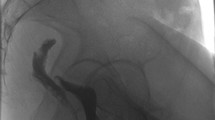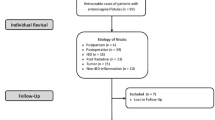Abstract
Background
The rectovaginal fistula (RVF) is a rare complication after low anterior resection (LAR) for rectal cancer. The aim of this study was to evaluate the risk factors for RVF after LAR for rectal cancer.
Methods
This was a retrospective multi-institution study of 371 female rectal cancer patients who underwent LAR with anastomosis between January 2007 and December 2011. Patient-, tumor-, and surgery-related variables were examined by univariate and multivariate analyses.
Results
The overall RVF rate was 3.0 % (11/371). The RVF was diagnosed on median postoperative day 83 (15–766). In 81.8 % (9/11) of the patients, the diagnosis of RVF was made after hospital discharge. Multivariate analysis identified prognostic nutritional index (PNI; odds ratio (OR) 6.97; 95 % confidence interval (CI) 1.47–33.08; P = 0.015), preoperative chemotherapy (OR 27.31; CI 3.49–213.62; P = 0.002), tumor size (OR 5.90; CI 1.04–33.47; P = 0.045), intraoperative bleeding (OR 13.91; CI 1.34–144.42; P = 0.027), and lateral lymph node dissection (OR 4.92; CI 1.02–23.63; P = 0.045) as independent risk factors for RVF after LAR.
Conclusions
Risk factors of RVF were PNI (<45), preoperative chemotherapy, tumor size (≧50 mm), intraoperative bleeding (≧200 ml), and lateral lymph node dissection. Before an operation, obtaining the information about these risk factors is of great importance in LAR for rectal cancer.
Similar content being viewed by others
References
Bangser M (2006) Obstetric fistula and stigma. Lancet 367(9509):535–536
Cook RJ, Dickens BM, Syed S (2004) Obstetric fistula: the challenge to human rights. Int J Gynaecol Obstet 87(1):72–77
Hotouras A, Ribas Y, Zakeri S, Murphy J, Bhan C, Chan C (2014) Gracilis muscle interposition for rectovaginal and anovaginal fistula repair: a systematic literature review. Color Dis Off J Assoc Coloproctol Great Brit Irel 5(10):12791. doi:10.1111/codi.12791
Tozer PJ, Balmforth D, Kayani B, Rahbour G, Hart AL, Phillips RK (2013) Surgical management of rectovaginal fistula in a tertiary referral centre: many techniques are needed. Color Dis Off J Assoc Coloproctol Great Brit Irel 15(7):871–877
Pata G, Pasini M, Roncali S, Tognali D, Ragni F (2014) Iatrogenic rectovaginal fistula repair by trans-perineal approach and pubo-coccygeus muscle interposition. Int J Surg Case Rep 5(8):527–531
Kin C, Gurland B, Zutshi M, Hull T (2012) Martius flap repair for complex rectovaginal fistula. Pol Przegl Chir 84(11):601–604
Rex JC Jr, Khubchandani IT (1992) Rectovaginal fistula: complication of low anterior resection. Dis Colon Rectum 35(4):354–356
Kosugi C, Saito N, Kimata Y, Ono M, Sugito M, Ito M, Sato K, Koda K, Miyazaki M (2005) Rectovaginal fistulas after rectal cancer surgery: incidence and operative repair by gluteal-fold flap repair. Surgery 137(3):329–336
van Onkelen RS, Gosselink MP, Thijsse S, Schouten WR (2014) Predictors of outcome after transanal advancement flap repair for high transsphincteric fistulas. Dis Colon Rectum 57(8):1007–1011
Gottgens KW, Smeets RR, Stassen LP, Beets G, Breukink SO (2014) The disappointing quality of published studies on operative techniques for rectovaginal fistulas: a blueprint for a prospective multi-institutional study. Dis Colon Rectum 57(7):888–898
Antonsen HK, Kronborg O (1987) Early complications after low anterior resection for rectal cancer using the EEA stapling device. A prospective trial. Dis Colon Rectum 30(8):579–583
Arbman G (1993) Rectovaginal fistulas and the double-stapling technique. Dis Colon Rectum 36(3):310–311
Baran JJ, Goldstein SD, Resnik AM (1992) The double-staple technique in colorectal anastomoses: a critical review. Am Surg 58(4):270–272
Fleshner PR, Schoetz DJ Jr, Roberts PL, Murray JJ, Coller JA, Veidenheimer MC (1992) Anastomotic-vaginal fistula after colorectal surgery. Dis Colon Rectum 35(10):938–943
Nakagoe T, Sawai T, Tuji T, Nanashima A, Yamaguchi H, Yasutake T, Ayabe H (1999) Avoidance of rectovaginal fistula as a complication after low anterior resection for rectal cancer using a double-stapling technique. J Surg Oncol 71(3):196–197
Sugarbaker PH (1996) Rectovaginal fistula following low circular stapled anastomosis in women with rectal cancer. J Surg Oncol 61(2):155–158. doi:10.1002/(SICI)1096-9098(199602)61:2<155::AID-JSO12>3.0.CO;2-8
Tsutsumi N, Yoshida Y, Maehara Y, Kohnoe S (2007) Rectovaginal fistula following double-stapling anastomosis in low anterior resection for rectal cancer. Hepatogastroenterology 54(78):1682–1683
Matthiessen P, Hansson L, Sjodahl R, Rutegard J (2010) Anastomotic-vaginal fistula (AVF) after anterior resection of the rectum for cancer--occurrence and risk factors. Color Dis Off J Assoc Coloproctol Great Brit Irel 12(4):351–357
Sobin LH GM, Wittekind C (2009) TNM classification of malignant tumours, 7th edn. Wiley-Blackwell. November
Conflict of interest
Jun Watanabe, Mitsuyoshi Ota, Daisuke Kawaguchi, Hidetaka Shima, Shuhei Kaida, Shunichi Osada, Nobuyuki Kamimukai, Noriyuki Kamiya, Atsushi Ishibe, Kazuteru Watanabe, Ryusei Matsuyama, Hirotoshi Akiyama, Yasushi Ichikawa, Mari Oba, and Itaru Endo have no conflicts of interest or financial ties to disclose.
Author information
Authors and Affiliations
Corresponding author
Rights and permissions
About this article
Cite this article
Watanabe, J., Ota, M., Kawaguchi, D. et al. Incidence and risk factors for rectovaginal fistula after low anterior resection for rectal cancer. Int J Colorectal Dis 30, 1659–1666 (2015). https://doi.org/10.1007/s00384-015-2340-5
Accepted:
Published:
Issue Date:
DOI: https://doi.org/10.1007/s00384-015-2340-5




